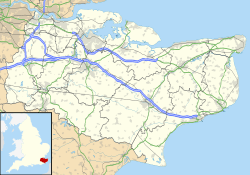Leeds Priory facts for kids
| Monastery information | |
|---|---|
| Established | 1119 |
| Disestablished | 1539 |
| Dedicated to | St Mary and St Nicholas |
| Diocese | Rochester |
| People | |
| Important associated figures | Robert de Crevequer |
| Site | |
| Location | Leeds, Kent |
| Coordinates | 51°14′50″N 0°36′40″E / 51.24722°N 0.61111°E |
| Visible remains | None |
| Other information | Site obliterated by the building of a mansion, itself demolished in the 18th century. |
Leeds Priory, also known as Leeds Abbey, was a priory (a type of monastery) in Leeds, Kent, England. It was started in 1119 and closed down in 1539. Later, a large house was built where the priory used to be. This house was then taken down in the late 1700s. Today, the area where the priory once stood is a protected historical site.
Contents
What Was Leeds Priory Like?
The first church at Leeds Priory was built in the Norman style. This means it had thick walls and round arches. It was made from local Kentish Ragstone and Caen stone for the corners. The church had a special entrance area called a vaulted porch.
Around the 1320s, the main part of the church, called the nave, was rebuilt. The north transept (the arm of the cross-shaped church) was made bigger. It was built in the fancy Decorated style, which had lots of detailed carvings. The south transept might have been rebuilt too.
Later, in the late 1380s or early 1390s, the presbytery (the area around the altar) was replaced. This was unusual because this part was usually rebuilt first. The land rising sharply behind the church might have made it hard to extend it. The chapter house, where the monks met, was next to the south transept and built around 1160.
The main church was at the northern part of the priory. Other buildings were to its east, west, and south. The warming house, where monks could get warm, was likely in the south building. The kitchen was also nearby.
The History of Leeds Priory
How Leeds Priory Began
The Priory of St Mary and St Nicholas, also called Leeds Abbey, was founded in 1119. It was started by Robert de Crevequer and his son Adam. The priory was home to the Black Friars, who were a group of monks.
In 1177, Robert de Crevequer's son, also named Robert, gave a fulling mill to the priory. A fulling mill was a place that used water power to clean and thicken cloth. This mill was on the River Len. The priory owned this mill until it closed down. They also owned another mill called Abbey Mill.
Royal Connections and Changes
In 1198, Pope Innocent III confirmed that the priory was connected to the Archbishop of Canterbury. Later, in 1368, King Edward III confirmed the gifts from the de Crevequer family. He also said that he would protect the priory.
Around 1384, the priory was valued at about £220. At this time, during the reign of King Richard II, a monk named Thomas Hazlewood came to Leeds Priory. He wrote several history books there, including A Compendious Chronicle. In 1452, King Richard III also confirmed the priory's rights and freedoms.
The Priory's End
By 1487, the priory was in a lot of debt. James Goldwell, who was the Bishop of Norwich, gave a lot of money to the priory. This helped them afford another priest.
Leeds Priory was closed down in 1539. This was part of a bigger event called the Dissolution of the Monasteries. At that time, the priory was valued at about £362. The last leader of the priory, Thomas Day, received a payment of £80 a year from King Henry VIII.
After the priory closed, the King rented it out to Anthony St Leger for 21 years. The rent was £22 a year. This rental included both mills, about 323 acres of land, and all the buildings connected to the priory. The priory itself was taken apart, and its materials were carried away.
In 1551, King Edward VI gave the priory site and some land to St Leger. The rest of the land had been given to the Dean and Chapter of Rochester in 1542.
Later Owners and Demolition
In 1559, Warham St Leger inherited the priory site from his father. In 1573, St Leger sold the estate to Sir William Meredith. A pigeon house was built on the priory grounds.
The estate passed through the Meredith family for many years. In 1723, it went to Sir Roger Meredith. When he died in 1738, he left it to his niece, Susanna Meredith. After she died in 1758, the estate went to Sir George Oxenden.
In 1765, Oxenden sold the estate to John Calcraft. He made the house much bigger and improved the gardens. Calcraft died in 1772, and his son, John, inherited the estate. The large house was taken down at the end of the 1700s.
Today, only the dovecote from the mansion remains. It is listed on the Historic England Heritage at Risk Register, meaning it needs care to be preserved.
Excavations and Discoveries
The site of the priory was partly dug up by archaeologists in 1846. In 1973, a more detailed excavation took place over eleven weeks. Groups like the Archaeological Society of Sir Joseph Williamson's Mathematical School, the Kent Archaeological Society, and others helped with this dig. These excavations help us learn more about what the priory was like.
Images for kids



